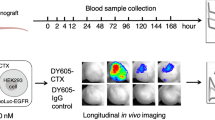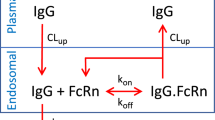Abstract
A mathematical model was developed to improve understanding of the biodistribution and microscopic profiles of drugs and prodrugs in a system using enzyme-conjugated antibodies as part of a two-step method for cancer treatment. The use of monoclonal antibodies alone may lead to heterogeneous uptake within the tumour tissue; the use of a second, low molecular weight agent may provide greater penetration into tumour tissue. This mathematical model was used to describe concentration profiles surrounding individual blood vessels within a tumour. From these profiles the area under the curve and specificity ratios were determined. By integrating these results spatially, average tissue concentrations were determined and compared with experimental results from three different systems in the literature; two using murine antibodies and one using humanised fusion proteins. The maximum enzyme conversion rate (Vmax) and the residual antibody concentration in the plasma and normal tissue were seen to be key determinants of drug concentration and drug-prodrug ratios in the tumour and other organs. Thus, longer time delays between the two injections, clearing the antibody from the blood stream and the use of 'weaker' enzymes (lower Vmax) will be important factors in improving this prodrug approach. Of these, the model found the effective clearance of the antibody outside of the tumour to be the most effective. The use of enzyme-conjugated antibodies may offer the following advantages over the bifunctional antibody-hapten system: (i) more uniform distribution of the active agent; (ii) higher concentrations possible for the active agent; and (iii) greater specificity (therapeutic index).
This is a preview of subscription content, access via your institution
Access options
Subscribe to this journal
Receive 24 print issues and online access
$259.00 per year
only $10.79 per issue
Buy this article
- Purchase on Springer Link
- Instant access to full article PDF
Prices may be subject to local taxes which are calculated during checkout
Similar content being viewed by others
Author information
Authors and Affiliations
Rights and permissions
About this article
Cite this article
Baxter, L., Jain, R. Pharmacokinetic analysis of the microscopic distribution of enzyme-conjugated antibodies and prodrugs: comparison with experimental data. Br J Cancer 73, 447–456 (1996). https://doi.org/10.1038/bjc.1996.80
Issue Date:
DOI: https://doi.org/10.1038/bjc.1996.80



